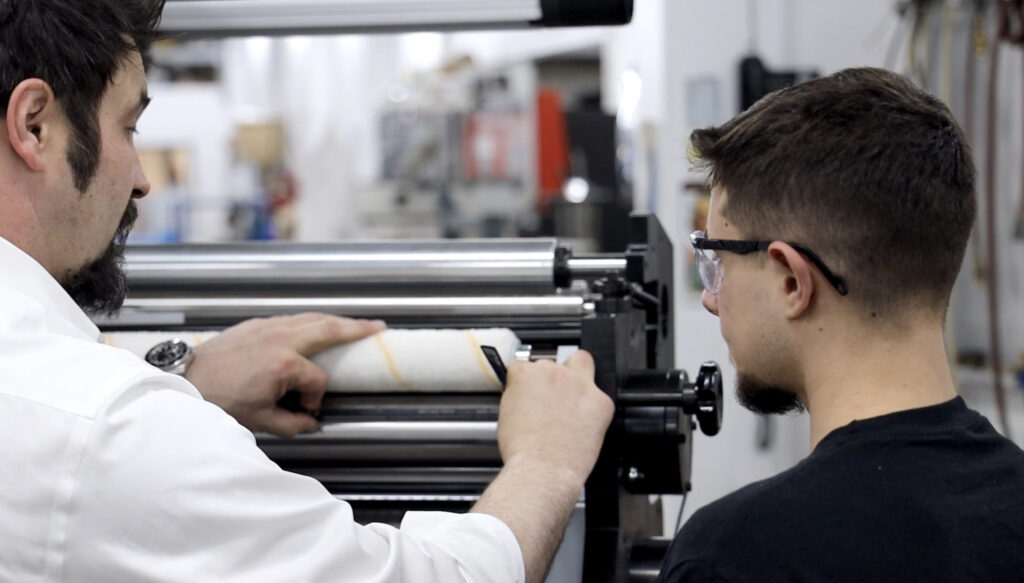Die cutting is the process of using a die, a tool typically made of metal, that cuts through the material to cut out pieces that are identical in shape and size. Die cutting is used to cut through various types of material such as plastic, adhesive, paper, fabric, and many others. The most popular types of die-cutting methods include flatbed, rotary, and laser die cutting, which does not use a tool but rather uses a laser to cut out identical shapes.
What are the Different Types of Die Cutting Methods?
Flatbed die cutting – this method of die cutting uses a hydraulic flatbed press to push blades down that cut through the material forming predetermined shapes.
Rotary die cutting – this die-cutting method utilizes a cylindrical die that has blades around the whole cylinder and cuts out shapes while moving in a circular motion. This is an efficient method with a die that cuts many identical shapes while rotating.
Laser die cutting – a laser is used to sear through the material instead of a steel die. Laser die cutting can cut out complex shapes, although it can destroy some adhesives and materials in the process.
Advantages of the Most Popular Die Cutting Methods
Each method of die-cutting offers different advantages depending on the scope of the project.
Flatbed Die Cutting: Preferred for Low Volume, Simple Cutting
Flatbed die cutting is a simple method of making clean cuts in thick material and sheeted form, similar to a cookie-cutter. This method is popular for low-volume projects, and tools can be changed quickly.
Rotary Die Cutting: Maintains Tight Tolerances with Quick Cutting
Rotary die cutting is like having cookie cutters on a rolling pin, continually cutting multiple shapes quickly on roll form material. The rotating cylinder blades with servo-driven motors maintain tight tolerances and registration. Rotary dies are durable and perfectly cut identical objects, which is critical in applications such as aerospace, medical, and the military.
Rotary die cutting may be the best solution when speed is the objective and for high-volume jobs.
Laser Die Cutting: Precision Cutting in a Highly Repeatable Process
Laser die cutting does not make contact with the substrate, using a laser to perform various cuts at high speeds. Laser die cutting provides high precision cutting in a highly repeatable process and can be the preferred choice for materials that could be damaged with other steel die cutting methods. For example, cutting squares or discs of sandpaper are typically cut with lasers as the paper itself would be damaged with metal die-cutting methods.
Laser die cutting is ideal for prototypes, as a program can alter the laser path quickly and at less cost than building a steel die just for prototyping parts. One advantage of laser die cutting is no maintenance compared to maintaining quality steel dies.
Tamarack® Offers Web Finishing and Window Patching Solutions
Tamarack® Products offers web finishing and in-line window patching equipment that is high-quality and customized to meet unique customer specifications. The Vista® Window Patcher in-line window patching equipment easily patches Windows for short-run and high-volume folding carton applications. Easily affix susceptor patches, rigid windows, and liners on specialty cartons with Tamarack’s Vista®.
Tamarack’s Versa Web® SE offline web finishing equipment produces integrated labels, forms, and cards and easily affixes magnets, scratch-off material, holograms, labels, and other roll-fed materials to direct mailings, promotional products, and business forms.
Tamarack® Products offers more than 50 years of experience in designing, engineering, and manufacturing high-quality, specialized machinery and die-cutting equipment used in the business forms, packaging, and label industries. We differ from other web finishing equipment manufacturers in our high level of technical expertise and ability to customize equipment to meet our customers’ needs. Contact us with any questions on selecting the right type of die-cutting method for your roll-fed material applications.





